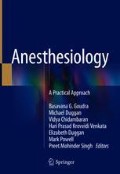Abstract
Office based anesthesia has grown in popularity in parallel with cosmetic procedures over the past decade. This is due to newer and safer anesthetic techniques combined with minimally invasive and novel surgical methods, allowing more procedures to be completed at out of hospital settings.
One of the main concerns of office based procedures is patient safety along with the availability of personnel and equipment to deal with complications and emergencies.
This chapter discusses the anesthetic management and techniques for office based cosmetic procedures, patient and procedure selection, office preparedness and patient safety.
Access this chapter
Tax calculation will be finalised at checkout
Purchases are for personal use only
References
Shapiro FE. Anesthesia for outpatient cosmetic surgery. Curr Opin Anaesthesiol. 2008;21(6):704–10.
Surgery TASfAP. Cosmetic surgery national data bank statistics 2016. Available from: https://www.surgery.org/sites/default/files/ASAPS-Stats2016.pdf.
Hunstad JP, Walk PH. Office-based anesthesia. Semin Plast Surg. 2007;21(2):103–7.
Weaver JM. The safety of both fixed and transportable office-based anesthesia for dentistry. Anesth Prog. 1999;46(1):1–2.
Ellsworth WA, Basu CB, Iverson RE. Perioperative considerations for patient safety during cosmetic surgery – preventing complications. Can J Plast Surg. 2009;17(1):9–16.
Shapiro FE, Punwani N, Rosenberg NM, Valedon A, Twersky R, Urman RD. Office-based anesthesia: safety and outcomes. Anesth Analg. 2014;119(2):276–85.
Hausman LM, Frost EA. Office-based surgery: expanding the role of the anesthesiologist. Middle East J Anaesthesiol. 2007;19(2):291–310.
Spring MA, Stoker DA, Holloway J, Weintraub M, Stevens WG. Office-based plastic surgery with general anesthesia: efficiency of cost and time. Semin Plast Surg. 2007;21(2):99–101.
Bitar G, Mullis W, Jacobs W, Matthews D, Beasley M, Smith K, et al. Safety and efficacy of office-based surgery with monitored anesthesia care/sedation in 4778 consecutive plastic surgery procedures. Plast Reconstr Surg. 2003;111(1):150–6; discussion 157–8.
Johnson PJ. General anesthesia in an office-based plastic surgical facility: a report on more than 23,000 consecutive office-based procedures under general anesthesia with no significant anesthetic complications. Arch Facial Plast Surg. 2001;3(4):287.
Friedberg BL. Propofol in office-based plastic surgery. Semin Plast Surg. 2007;21(2):129–32.
Friedberg BL. Propofol ketamine anesthesia for cosmetic surgery in the office suite. Int Anesthesiol Clin. 2003;41(2):39–50.
Vinnik CA. Dissociative anesthesia in an office-based plastic surgery practice. Semin Plast Surg. 2007;21(2):109–14.
Friedberg BL. Propofol-ketamine technique. Aesthetic Plast Surg. 1993;17(4):297–300.
Quttainah A, Carlsen L, Voice S, Taylor J. Ketamine-diazepam protocol for intravenous sedation: the cosmetic surgery hospital experience. Can J Plast Surg. 2004;12(3):141–3.
Blake DR. Office-based anesthesia: dispelling common myths. Aesthet Surg J. 2008;28(5):564–70; discussion 571–2.
Wang G, Cao WG, Li SL, Liu LN, Jiang ZH. Safe extensive tumescent liposuction with segmental infiltration of lower concentration lidocaine under monitored anesthesia care. Ann Plast Surg. 2015;74(1):6–11.
Klein JA. Tumescent technique for regional anesthesia permits lidocaine doses of 35 mg/kg for liposuction. J Dermatol Surg Oncol. 1990;16(3):248–63.
Sood J, Jayaraman L, Sethi N. Liposuction: anaesthesia challenges. Indian J Anaesth. 2011;55(3):220–7.
Kenkel JM, Lipschitz AH, Luby M, Kallmeyer I, Sorokin E, Appelt E, et al. Hemodynamic physiology and thermoregulation in liposuction. Plast Reconstr Surg. 2004;114(2):503–13; discussion 514–5.
Rohrich RJ, Leedy JE, Swamy R, Brown SA, Coleman J. Fluid resuscitation in liposuction: a retrospective review of 89 consecutive patients. Plast Reconstr Surg. 2006;117(2):431–5.
Nekhendzy V, Ramaiah VK. Prevention of perioperative and anesthesia-related complications in facial cosmetic surgery. Facial Plast Surg Clin North Am. 2013;21(4):559–77.
Beer GM, Goldscheider E, Weber A, Lehmann K. Prevention of acute hematoma after face-lifts. Aesthetic Plast Surg. 2010;34(4):502–7.
Iannitti T, Capone S, Palmieri B. Short review on face rejuvenation procedures: focus on preoperative antiseptic and anesthetic delivery by JetPeel-3 (a high pressure oxygen delivery device). Minerva Chir. 2011;66(3 Suppl 1):1–8.
Byrne TK. Complications of surgery for obesity. Surg Clin North Am. 2001;81(5):1181–93; vii–viii.
Ganzberg S. Obstructive sleep apnea and office-based surgery. Anesth Prog. 2016;63(2):53–4.
Joshi GP, Ankichetty SP, Gan TJ, Chung F. Society for Ambulatory Anesthesia consensus statement on preoperative selection of adult patients with obstructive sleep apnea scheduled for ambulatory surgery. Anesth Analg. 2012;115(5):1060–8.
Tan KB, Toh ST, Guilleminault C, Holty JE. A cost-effectiveness analysis of surgery for middle-aged men with severe obstructive sleep apnea intolerant of CPAP. J Clin Sleep Med. 2015;11(5):525–35.
Apfel CC, Korttila K, Abdalla M, Kerger H, Turan A, Vedder I, et al. A factorial trial of six interventions for the prevention of postoperative nausea and vomiting. N Engl J Med. 2004;350(24):2441–51.
Phillips BT, Wang ED, Rodman AJ, Watterson PA, Smith KL, Finical SJ, et al. Anesthesia duration as a marker for surgical complications in office-based plastic surgery. Ann Plast Surg. 2012;69(4):408–11.
Yi MS, Kang H, Kim MK, Choi GJ, Park YH, Baek CW, Jung YH, Woo YC. Relationship between the incidence and risk factors of postoperative nausea and vomiting in patients with intravenous patient-controlled analgesia. Asian J Surg. 2017. https://doi.org/10.1016/j.asjsur.2017.01.005. pii: S1015-9584(16)30464-X. PMID 28372932.
Fujii Y. Prophylaxis of postoperative nausea and vomiting in patients scheduled for breast surgery. Clin Drug Investig. 2006;26(8):427–37.
Trimas SJ, Trimas MD. Use of aprepitant and factors associated with incidence of postoperative nausea and vomiting in patients undergoing facial plastic surgery. JAMA Facial Plast Surg. 2015;17(4):251–5.
Morello DC, Colon GA, Fredricks S, Iverson RE, Singer R. Patient safety in accredited office surgical facilities. Plast Reconstr Surg. 1997;99(6):1496–500.
Keyes GR, Singer R, Iverson RE, McGuire M, Yates J, Gold A, et al. Mortality in outpatient surgery. Plast Reconstr Surg. 2008;122(1):245–50; discussion 251–3.
Urman RD, Punwani N, Shapiro FE. Office-based surgical and medical procedures: educational gaps. Ochsner J. 2012;12(4):383–8.
Author information
Authors and Affiliations
Corresponding author
Editor information
Editors and Affiliations
Rights and permissions
Copyright information
© 2018 Springer International Publishing AG, part of Springer Nature
About this chapter
Cite this chapter
Dawood, S.S., Green, M.S. (2018). Anesthesia for Office Based Cosmetic Procedures. In: Goudra, B., et al. Anesthesiology. Springer, Cham. https://doi.org/10.1007/978-3-319-74766-8_27
Download citation
DOI: https://doi.org/10.1007/978-3-319-74766-8_27
Published:
Publisher Name: Springer, Cham
Print ISBN: 978-3-319-74765-1
Online ISBN: 978-3-319-74766-8
eBook Packages: MedicineMedicine (R0)

